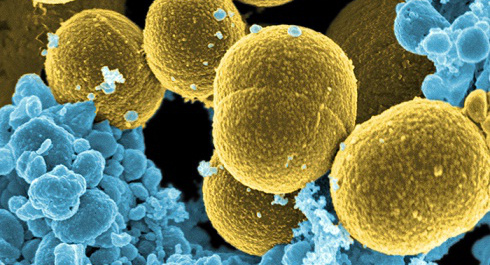Best Wastewater Treatment Plants Can't Filter Out Superbug Fragments

S. aureus bacteria.
Image Credit: NIAID | RML
(ISNS) -- Even a very good wastewater treatment plant can't clean up fragments of superbugs -- bacteria that have developed a resistance to antibiotics -- and until now, almost no one has noticed.
The implications are unclear -- researchers did not look for whole living bacteria, just for dead fragments of their genetic material -- but experts are concerned. Superbugs have developed resistance to almost every kind of antibiotic. They are building resistance faster than science can create new drugs. Many of them are deadly.
Timothy LaPara and a team of researchers at the University of Minnesota in the Twin Cities, testing water pouring from a modern water treatment facility in Duluth, found genes of drug-resistant bacteria in the discharge. Most American cities do not have facilities as good as Duluth's, but no one knows for sure how much worse the situation may be at those facilities because it has not been measured.
"This is not a trivial thing to miss," said Ellen Silbergeld, professor and editor-in-chief of Environmental Research at the Johns Hopkins Bloomberg School of Public Health. Silbergeld said LaPara shows the situation is more troubling than many had thought.
The best-known superbug is MRSA, methicillin-resistant Staphylococcus aureus, which even has been found in the locker room of a National Football League team but usually picked up in hospitals. It is sometimes defeated by massive doses of multiple antibiotics, but not always.
A new superbug, Clostridium difficile, which can cause a fatal colon inflammation, now is on the rise. Two antibiotics work for that bug most -- but not all -- of the time. A quarter of patients relapse and some will die.
While there has been some progress in reducing outbreaks by better practices, such as careful hand washing in hospitals, the situation remains serious. Alcohol-based hand rinsers kill Clostridium difficile, but not its spores.
The increase in superbugs is usually blamed on the extensive use of antibiotics in agriculture, especially chicken and meat, and the over-prescription of antibiotics by physicians. A study released this week from the Center for Disease Dynamics, Economics & Policy in Washington, D.C. reported an increased overuse of antibiotics in the United States, particularly in the Southeast.
The resistance problem is exacerbated by people who do not follow directions and quit taking their pills too soon.
LaPara did not look for any particular bacteria; he was searching for genes of bacteria that would have superbug attributes. The genes LaPara found came from bacteria formed in the digestive system, excreted and then sent through the sewer systems to municipal wastewater treatment plants.
LaPara and his graduate students selected Duluth because it has one of the most advanced waste water treatment plants in the country, he said, and is surrounded by pristine natural water, the St. Louis River and Lake Superior.
Unlike most sewage plants, the Duluth facility uses triple-filtering technologies. Only a few places, such as Singapore, have better plants, LaPara said.
"It is the Lamborghini of sewer plants," LaPara said, probably better than 95 percent of the plants in the U.S., he said.
In the paper, published in the journal Environmental Science and Technology, LaPara’s team, mostly PhD students, reported they found 20 times more of the genes in the water released from the plant into Duluth-Superior Harbor than in nearby bodies of water. Genes of some superbugs were so rare in the river and lake away from the plant, they didn't show up in measurements.
"The background level was essentially zero," LaPara said.
While the amount of bacterial particles in the discharge was much better than is likely from less-efficient plants, "I wouldn’t go up and take a drink," LaPara said.
LaPara did not know the public health ramifications of the bacteria in the water.
Silbergeld said the study was "incredibly important," because American treatment plants are designed to meet standards set by the Environmental Protection Agency, and the EPA standards ignore these kinds of bacteria.
EPA standards are aimed at coliform bacteria such as E. coli, usually found in feces, and if the plant does a decent job getting rid of those, the plant is considered operating properly. Plants are designed to meet those standards.
The threat from spreading superbugs is not considered or measured.
"The paper is laying out for us how bad this is," Silbergeld said.

